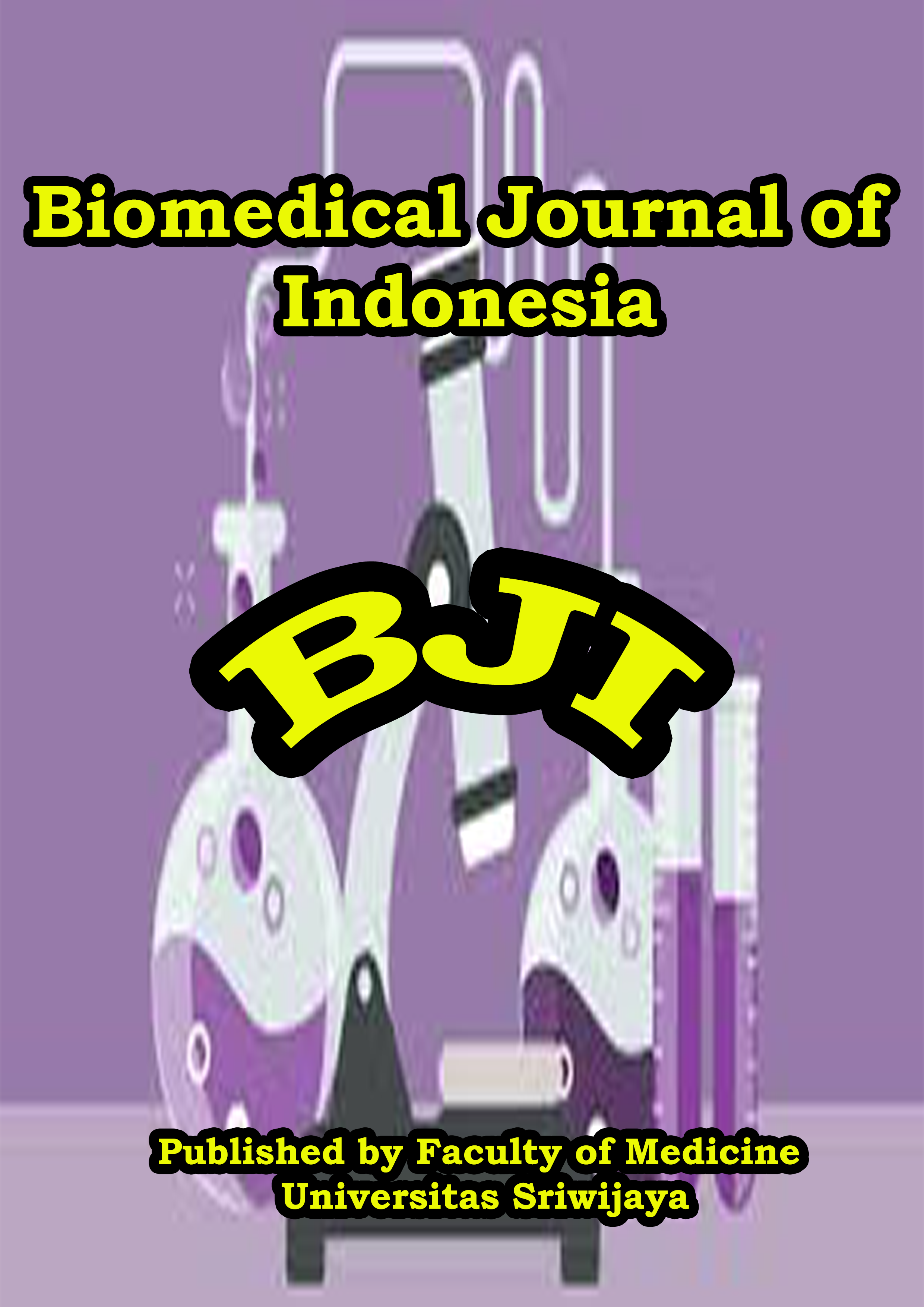Potency of Karamunting (Rhodomyrtus tomentosa) Leaf Extract as Antidiabetic for Type 2 Diabetes: A Systematic Review
Main Article Content
Type 2 diabetes mellitus (T2D) is a chronic metabolic disorder characterized by reduced insulin sensitivity and inadequate insulin secretion, leading to elevated blood glucose levels. Standard treatment relies on synthetic drugs, which can cause adverse effects in some patients. Rhodomyrtus tomentosa, a plant native to Indonesia and widely used in traditional medicine, is being explored as a natural alternative for diabetes management due to its potential antidiabetic properties. This review compiles recent findings on its therapeutic potential. A systematic literature search was conducted in August 2024 in PubMed, Wiley Online Library, ScienceDirect, Cochrane Library, ProQuest, and Google Scholar using the keywords “Rhodomyrtus tomentosa” and “antidiabetic.” Of 774 screened articles, five met the inclusion criteria (2014–2024). The studies employed in vitro, in vivo, and in silico approaches, focusing mainly on fruits and leaves. Results indicate that R. tomentosa may help control blood glucose by inhibiting α-glucosidase and α-amylase, enzymes critical in carbohydrate digestion. Bioactive compounds such as phloroglucinols and meroterpenes were frequently identified. However, most evidence comes from laboratory models, with limited animal research and no clinical trials. The risk of bias was moderate, often due to incomplete reporting. While findings suggest R. tomentosa is a promising natural candidate for diabetes treatment, its therapeutic value remains unconfirmed. More robust in vivo studies and human clinical trials are essential to clarify its mechanisms, safety, pharmacokinetics, and efficacy. This review serves as a basis for future research and highlights the need for rigorous studies to validate its clinical potential.
2. Arroyo-Johnson C, Mincey KD, Ackermann N, Milam L, Goodman MS, Colditz GA. Racial and Ethnic Heterogeneity in Self-Reported Diabetes Prevalence Trends Across Hispanic Subgroups, National Health Interview Survey, 1997–2012. Prev Chronic Dis. 2016 Jan 21;13:150260.
3. Takeuchi M, Kawamura T, Sato I, Kawakami K. Population‐based incidence of diabetic ketoacidosis in type 2 diabetes: medical claims data analysis in Japan. Pharmacoepidemiol Drug Saf. 2018 Jan 28;27(1):123–6.
4. Ramachandran A. Know the signs and symptoms of diabetes. Indian J Med Res. 2014 Nov;140(5):579–81.
5. Santos J, Woloski JR, Wu N. Polyuria and Acute Hyperglycemia Secondary to New-Onset Diabetes in a Young Woman With Friedreich’s Ataxia. Cureus. 2021 Jun 29;13(6):e16032.
6. American Diabetes Association. Standards of Medical Care in Diabetes—2011. Diabetes Care. 2011 Jan 1;34(Supplement_1):S11–61.
7. Weinberg Sibony R, Segev O, Dor S, Raz I. Drug Therapies for Diabetes. Vol. 24, International Journal of Molecular Sciences. Multidisciplinary Digital Publishing Institute (MDPI); 2023.
8. Ludvik B, Frías JP, Tinahones FJ, Wainstein J, Jiang H, Robertson KE, et al. Dulaglutide as add-on therapy to SGLT2 inhibitors in patients with inadequately controlled type 2 diabetes (AWARD-10): a 24-week, randomised, double-blind, placebo-controlled trial. Lancet Diabetes Endocrinol. 2018 May 1;6(5):370–81.
9. Chaudhury A, Duvoor C, Reddy Dendi VS, Kraleti S, Chada A, Ravilla R, et al. Clinical Review of Antidiabetic Drugs: Implications for Type 2 Diabetes Mellitus Management. Front Endocrinol (Lausanne). 2017;8.
10. Blonde L, Dipp S, Cadena D. Combination Glucose-Lowering Therapy Plans in T2DM: Case-Based Considerations. Adv Ther. 2018 Jul 18;35(7):939–65.
11. Tran N, Pham B, Le L. Bioactive compounds in anti-diabetic plants: From herbal medicine to modern drug discovery. Vol. 9, Biology. MDPI AG; 2020. p. 1–31.
12. Yang M, Guo M yang, Luo Y, Yun M dong, Yan J, Liu T, et al. Effect of Artemisia annua extract on treating active rheumatoid arthritis: A randomized controlled trial. Chin J Integr Med. 2017;23(7):496–503.
13. Hu X, Chen Y, Dai J, Yao L, Wang L. Rhodomyrtus tomentosa Fruits in Two Ripening Stages: Chemical Compositions, Antioxidant Capacity and Digestive Enzymes Inhibitory Activity. Antioxidants. 2022;11(7).
14. Mulyati B, Panjaitan RS. Study of Molecular Docking of Alkaloid Derivative Compounds from Stem Karamunting (Rhodomyrtus tomentosa)Against α-Glucosidase Enzymes. J Chem Res. 2021;9(2):129–36.
15. Idris M, Sukandar ER, Purnomo AS, Martak F, Fatmawati S. Antidiabetic, cytotoxic and antioxidant activities of Rhodomyrtus tomentosa leaf extracts. RSC Adv. 2022 Sep 9;12(39):25697–710.
16. Yu MY, Liu SN, Luo EE, Jin Q, Liu H, Liu HY, et al. Phloroglucinols with hAChE and α-glucosidase inhibitory activities from the leaves of tropic Rhodomyrtus tomentosa. Phytochemistry. 2022;203:113394.
17. Ma SJ, Yu J, Yan DW, Wang DC, Gao JM, Zhang Q. Meroterpene-like compounds derived from β-caryophyllene as potent α-glucosidase inhibitors. Org Biomol Chem. 2018;16(48):9454–60.
18. Huang Y, Richardson SJ, Brennan CS, Kasapis S. Mechanistic insights into α-amylase inhibition, binding affinity and structural changes upon interaction with gallic acid. Food Hydrocoll. 2024 Mar;148:109467.
19. Oboh G, Ogunsuyi OB, Ogunbadejo MD, Adefegha SA. Influence of gallic acid on α-amylase and α-glucosidase inhibitory properties of acarbose. J Food Drug Anal. 2016 Jul;24(3):627–34.
20. Yuan Q, Zhang X, Wei W, Zhao J, Wu Y, Zhao S, et al. Lycorine improves peripheral nerve function by promoting Schwann cell autophagy via AMPK pathway activation and MMP9 downregulation in diabetic peripheral neuropathy. Pharmacol Res. 2022 Jan;175:105985.
21. Praparatana R, Maliyam P, Barrows LR, Puttarak P. Flavonoids and Phenols, the Potential Anti-Diabetic Compounds from Bauhinia strychnifolia Craib. Stem. Molecules. 2022 Apr 7;27(8):2393.
22. Thupakula S, Nimmala SSR, Dawood SM, Padiya R. Synergistic anti-diabetic effect of phloroglucinol and total procyanidin dimer isolated from Vitis vinifera methanolic seed extract potentiates via suppressing oxidative stress: in-vitro evaluation studies. 3 Biotech. 2024 Mar 14;14(3):76.
23. Bracken AK, Gekko CE, Suss NO, Lueders EE, Cui Q, Fu Q, et al. Biomimetic Synthesis and Chemical Proteomics Reveal the Mechanism of Action and Functional Targets of Phloroglucinol Meroterpenoids. J Am Chem Soc. 2024 Jan 31;146(4):2524–48.

